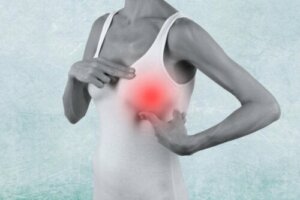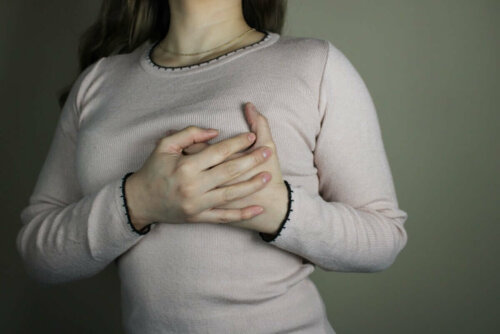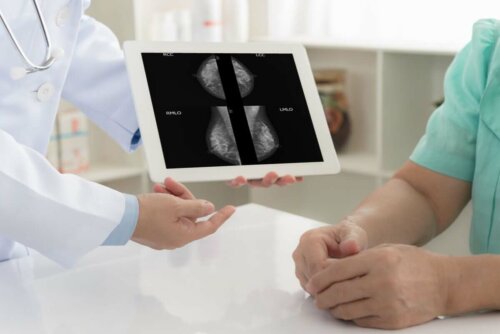Characteristics and Causes of Breast Lumps


Reviewed and approved by the doctor Leonardo Biolatto
Breast cancer is one of the most feared diseases in women of all ages. So, it’s no wonder they worry when they find they have breast lumps. Most of these are benign but why do they appear? Continue reading to find out.
First of all, let’s be clear that breasts are composed of different types of tissue: glandular, adipose, and connective parts. Thus, certain lumps and masses are normal in a breast.
What exactly are breast lumps?
This is a frequent reason for gynecological consultations as the mere thought of a lump generates anxiety and concern. Breast lumps are deep lesions with a different texture from the surrounding tissue and they vary in diameter.
In addition, a lump doesn’t change throughout the menstrual cycle and usually creates asymmetry with respect to the contralateral breast. It could be painful at times and there may also be secretion from the nipple.
Many people associate breast lumps with breast cancer. This is sort of unfounded though, after all, studies revealed these are benign in over 80% of cases. In fact, many of them can be due to hormonal changes during the menstrual cycle or lactation.

Types of breast lumps
Currently, many conditions could manifest as either benign or malignant breast lumps.
Benign lumps
These aren’t indicative of the presence of cancer and the lump’s edges feel defined, soft, painful, and there are few alterations in the skin.
These are among the most common causes:
- Hormonal changes during menstruation
- Breast abscesses
- Fibroadenomas
- Breast cysts
- Intraductal lipomas and papillomas
- Ductal ectasia
Malignant lumps
In most of these cases, breast lumps begin as benign and then turn into a carcinoma. They feel hard, have irregular edges, and they’re immobile, not painful, and alter the skin or nipple.
This type of masses is more frequent in women around the age of 40. A doctor must conduct several complementary exams in order to properly diagnose them. These may include a breast ultrasound, a mammogram, or a biopsy.
Find out about a Treatment for Breast Cysts
Possible causes of breast lumps
We’ve mentioned some of the pathologies that can lead to this type of condition. However, it’s time to go deeper into the three most common causes. All of them require a medical approach.
1. Breast abscesses
This pathology is frequent in young women who are either pregnant or breastfeeding. Breast abscesses manifest as painfully inflamed masses. Thus, the area may be red, enlarged, and warm to the touch.
These are the result of a bacterial infection and it usually starts as mastitis. It can result in a superinfection in which purulent fluid accumulates if left untreated and thus gives rise to an abscess.
The treatment for this condition is no different from that in abscesses in other parts of the body. In this respect, the fluid contained in them can be drained — depending on their size. They’re quite painful but can disappear in a matter of weeks with the right treatment.
2. Breast cysts
These are the most common cause of breast lumps. In fact, estimates indicate that 90% of women have them at some point. This type of malformation is common in young people between the ages of 20 and 40. They may be due to hormonal changes although the cause isn’t well determined yet.
These accumulations of liquids contained in a soft consistency capsule of mobile, variable size, can become bilateral. Unlike breast abscesses, the liquid is seldom infected; so there’s no inflammation.
However, some breast cysts can be painful and cause mastalgia during menstruation. There are no studies that relate this alteration with the risk of breast cancer but checkups are highly recommended.
Currently, there’s no specific treatment for this condition. Doctors may recommend draining them if they generate a lot of discomforts or have a large size. Still, there’s a risk of reappearance.
Read about the BRCA-1 and BRCA-2 Genes and Breast Cancer
3. Fibroadenoma
This is a benign breast lump that forms when the mammary gland grows irregularly. It’s often confused with a malignant one because it’s hard, painless, mobile, and may continue to grow over time.
There are three types of fibroadenomas: simple, complex, and giant ones.
- The first are tumors smaller than 2 inches in which all the cells that constitute it have similar characteristics. That is, there’s no risk of malignancy.
- Similarly, complex fibroadenomas have a certain degree of cellular atypia. That is, the cells begin to vary from one to another. However, according to the American Cancer Society, the risk of developing a carcinoma from a fibroadenoma doesn’t significantly increase.
- Finally, the giant ones are those that exceed 2 inches in diameter. They disappear over time in most cases. It’ll only be necessary to constantly monitor yourself in order to detect any changes in size or shape.
Extreme cases may require surgical extraction, especially when the lump is too bothersome or large. However, they can reappear — just like breast cysts.

Recommendations in the presence of a breast lump
As you can see, having a breast lump isn’t synonymous with cancer, as they’re most likely benign. However, you must always consult your doctor so they can do tests and give you an accurate diagnosis.
In addition, all women should do a breast self-exam at least once a month. This is because it’s the only way to be familiar with the anatomy of their breasts and thus be able to detect any possible abnormalities.
Thanks for reading.
All cited sources were thoroughly reviewed by our team to ensure their quality, reliability, currency, and validity. The bibliography of this article was considered reliable and of academic or scientific accuracy.
- Jiménez VX, Rivera HM, García RFM, et al. Nódulo mamario palpable. Abordaje diagnóstico. Revista del Hospital Juárez de México. 2011;78(1):35-40.
- Gallego G. Nódulo palpable de mama. Revista Colombiana de Obstetricia y Ginecología. 2005;56(1):82-1.
- Aznar F, Cortadellas T, Xercavins J. Patología benigna de la mama II: Tumores benignos de mama. Fundamentos de Ginecología. Sociedad Española de Ginecología y Obstetricia SEGO. 2005:483-92.
- Bajo Arenas J, Melchor Marcos J, Mercé Alberto L. Fundamentos de Ginecología (SEGO). Sociedad Española de Ginecología y Obstetricia; 2009.
- Gallego G. Nódulo Palpable de Mama. Revista de Colombiana de Obstetricia y Ginecología. 2005;56(1):82-91.
- Kosir M. Tumoraciones mamarias (nódulos de mama) – Ginecología y obstetricia – Manual MSD versión para profesionales [Internet]. Manual MSD versión para profesionales. 2019.
- Gallardo, María García, et al. “Lesiones papilares intraductales mamarias: nuestra experiencia 2007-2017.” Revista de Senología y Patología Mamaria 33.3 (2020): 88-93.
- Mendoza Salazar, Jennifer Vanessa. Nivel de asociación entre nódulos mamarios en adolescentes y su menarquía. Diss. Universidad de Guayaquil. Facultad de Ciencias Médicas. Carrera de Medicina, 2018.
- Delgado, S., et al. “Mastitis infecciosas durante la lactancia: un problema infravalorado (I).” Acta Pediatr Esp 67.2 (2009): 77-84.
- Loke, Benjamin Nathanael, et al. “Genetics and genomics of breast fibroadenomas.” Journal of Clinical Pathology 71.5 (2018): 381-387.
- Rodríguez López, Pilar, et al. “Fibroadenoma gigante juvenil de mama: Presentación de un caso clínico.” Revista chilena de obstetricia y ginecología 85.4 (2020): 376-382.
This text is provided for informational purposes only and does not replace consultation with a professional. If in doubt, consult your specialist.








